INHALE is a cultural platform where artists are presented, where great projects are given credit and readers find inspiration. Think about Inhale as if it were a map: we can help you discover which are the must-see events all over the world, what is happening now in the artistic and cultural world as well as guide you through the latest designers’ products. Inhale interconnects domains that you are interested in, so that you will know all the events, places, galleries, studios that are a must-see. We have a 360 degree overview on art and culture and a passion to share.

London based artist Jan Manski is interested in forms of utopia in a future world, and his works question themes such as beauty and the fragility of the human body. We’ve talked to him about his trilogy that includes his series Possesia, Onania and future Eugenica.
We are curious to know, first of all, how you’ve imagined this project that has three parts: Possesia, Onania, Eugenica and why you specifically wanted it to be made of three parts. How are they linked, where does it start from and where are you taking it?
The project came gradually in time, it wasn’t pre-designed. The trilogy idea has emerged from years of process. Possesia started first, with initial ideas and sketches dating to 2007. It grew out of my obsessive collecting habits and interest in a specific period of Europe’s history, a period of innocence just before the First World War. For years I visited flea markets to collect curious antique objects and photographs that transported me to the time they had witnessed.
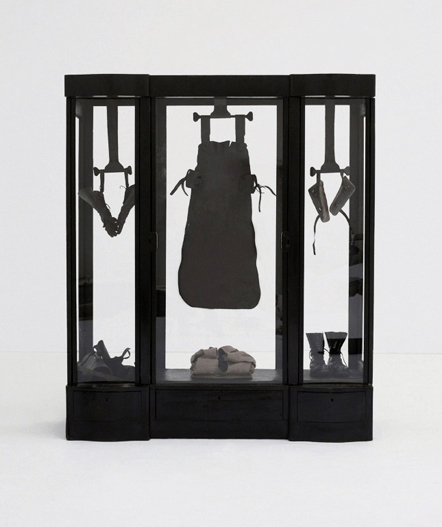
Primal Elements (detail), Jan Manski,
2010 / dimensions variable / pieces of furniture, glass, animal
skulls, leather, weights, boots, gloves, outfit, roller screen
photo janmanski.com
The second series of the trilogy to emerge was Onania, which addresses consumerist culture, while the third part, futuristic Eugenica, is in the early stages of development. All three parts are visions, myths of the human condition or complex hallucinations of human fascinations, obsessions and fears. They all operate in the same life-size scale and create equally rich environments.
Many of your works focus on the human body, not on its natural form, but rather on possible mutations. Why is that?
The body and its fragile nature is at the core of the whole idea. We define beauty through facial symmetry and the seamless body. As humans we are very sensitive to the mutated body image, as it disturbs us and works on our subconscious emotions. The whole trilogy presents the past, present and future through the prism of the human body. In Possesia the body merges with early forms of machinery, referring to the Industrial Revolution and how it affected humanity over two world wars.
Where Possesia is very masculine and its materials are raw, Onania shows a more feminine side. Here we see the body changed by narcissism and obsessive consumerism. The third part, Eugenica presents the body in the context of androgyny, genetic experiments and history of the euthanasia programmes. Behind the whole trilogy is human pride and supremacy leading to self-destruction.
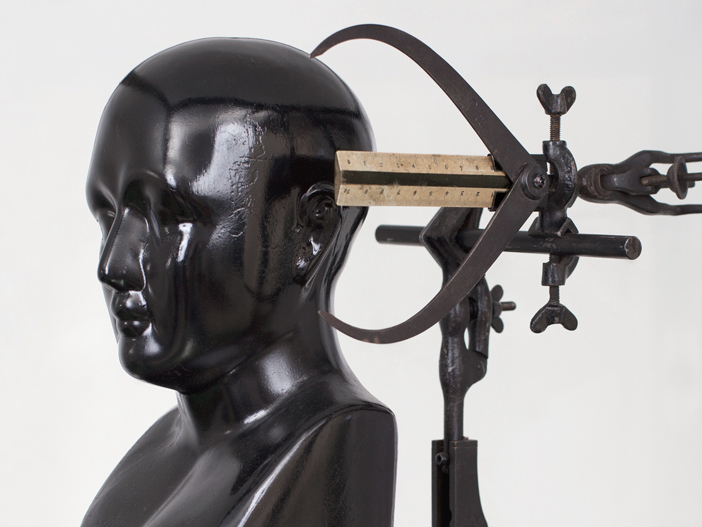
Implement I (detail), Jan Manski
2013 / 183 x 60 x 60 cm (72 x 23 5/8 x 23 5/8 in)
porcelain head, enamel, found microscope stand, steel, pieces
of laboratory equipment, ruler, measuring instrument, vitrine
photo janmanski.com
In Possesia, the Idol is mentioned as “the grand Master of Ceremonies, whose oppressive authority is only implied by his absence.“ Who is he?
The Idol is a shaman, dictator, preparer, architect and Greek demi-god. He is a butcher and Catholic priest in one. The Idol is the personification of all of these things. He represents high authority and influential power. The Idol appears to hold the momentum to move the whole Possesia mechanism and gives motion for things to come. Possesia is a return to the primal tribal phases of evolution, cruel and autocratic. The Idol cyclically returns and leads his believers to glory, always resulting in their self-destruction.
In which way are you interested in religion? How is this reflected in your works?
I come from a country with a very long tradition of oppressive authority from the Catholic church. In Poland Christian fundamentalism is still very strong and omnipresent. Religion is present in schools, priests are rich, privileged and held in high status. It all prevents tolerance, freedom and mental development of the whole nation. Churches are full and the far right’s preaching spreads homophobia, intolerance and other values alike. Growing up in this atmosphere has no doubt shaped my worldview and my art.
Mixing synthetic with organic materials make your works look unnatural, like a new body. What do these two different areas give you?
Materials and objects have always been full of meanings to me. In Possesia steel and machinery parts are mixed with soil, skulls and horns. Assembled together, metaphors of strength and vanity emerge. In Onania, delicate pastel textures and high quality mannequins mould into one form with fat, bones, leather and cosmetics. The result speaks for itself.
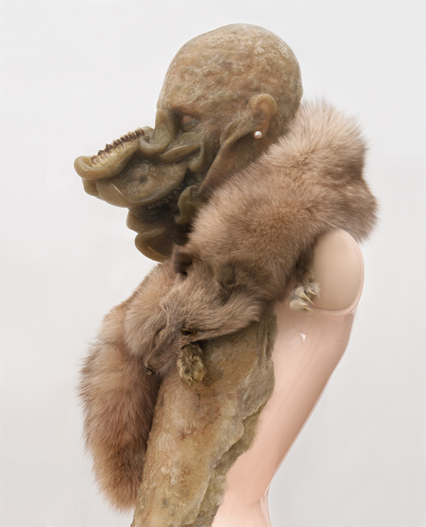
Aetiology Unknown 24 (detail), Jan Manski,
2012 / 190 x 60 x 60 cm (74 7/8 x 23 5/8 x 23 5/8 in)
fat, leather, fur, mannequin, jaws, enamel cosmetics,
earrings, polyvinyl acetate, vitrine
photo janmanski.com
The atmosphere of this project is gloomy. If you put beautiful things on top ugly, the result is grotesque, just like in the works with the magazine Ma Dame and Elle. Why are you interested in grotesque?
In medieval times The Joker was often the one who was able to pass unpleasant news to the king. Any other person delivering the same news in a serious way would have been decapitated. For me humour and the grotesque are the ways to open discussion between the lines. The magazine aesthetic defines the idea behind Onania. I’m playing with irresistible glamorous beauty infected by deadly mutation that is oozing out from behind a seamless facade.
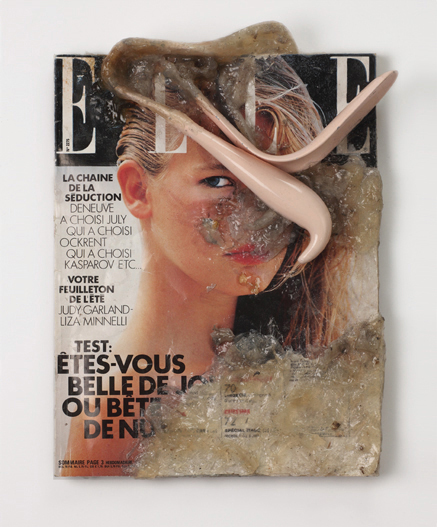
Mutation Study 93, Jan Manski,
2012 / 34 x 23 cm (13 3/8 x 9 in)
cosmetics, medical instrument, vintage magazine, tape, fat
photo janmanski.com
In Onania, it seems that a body that went through liposuction is a mutilated body. Can you explain why that is?
Onania’s inhabitants are focused on themselves, obsessed with the pleasure of consumption. I’m interested in creating the most narcissistic of worlds. There are three main references that create it: fashion, plastic surgery and the advertising industry. It’s like mapping society, finding society’s wounds and touching them. Liposuction acts like a metaphor here, its meaning is not symbolic, it’s open for interpretation.
You work with mannequins and fat, you must be aware of how the idea of beauty changes with the passing of time. How do you see the contemporary standard of beauty?
The definition of beauty changes and is dependent on culture, place and time. In ancient Greece there was an idea that beauty was equal to truth. Now we come to the exact opposite of that. The new perfection is mostly artificial and unhealthy. In Onania I’m confronting the modern notion of glamour with the idea of medieval plagues. In this world, those who have fallen in love with the beauty of themselves are surrounded with a glamorous pink reality where they meet their fate. It’s a reference to ideas of karma, sin and punishment. It’s present in many mythologies as one of the main axes of culture.
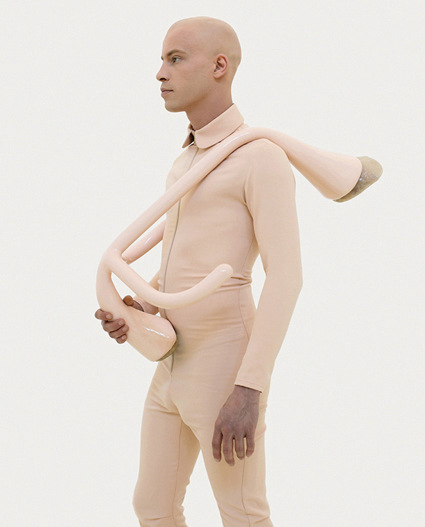
The Onanizer Strain II, Jan Manski,
2011 / 70 x 55 cm (27 9/16 x 21 5/8 in)
ultrachrome print
photo janmanski.com
In which way does contemporary society make sacrifices for beauty? Do you think that compared to other periods of time, the sacrifices made today are bigger?
Now we have more technical abilities, more tools to follow our obsessions enforced by the constant fear of social exclusion. The advertising industry parody The Onanizer is a part of Onania that causes rapid consumption. One journalist compared the cruel deformations in Onania to that of a selfish, bored aristocracy punished for their ignorance. I liked that interpretation.
Do you think that there will be even more extreme sacrifices in the future? Why? Some installations are of surgery rooms: the bed and the curtains are represented with details. Why did you choose to go this close to the process itself?
Onania’s Aetiology Unknown series are like the mirrors of Narcissus facing his worst nightmare. My intention was to create the essence of a luxurious fashion-related environment that is being consumed by mysterious mutation. The subjects are body-like mutations frozen in motion, stills of the process. I’ve visited old Polish hospitals to choose the perfect items for these installations. The goal was to make it like a perfectly real hallucination, rich in detail. I think that the power of art is possible to achieve when all elements are creating a unique balance. When even one more element is added or one is taken away, the whole thing is ruined.
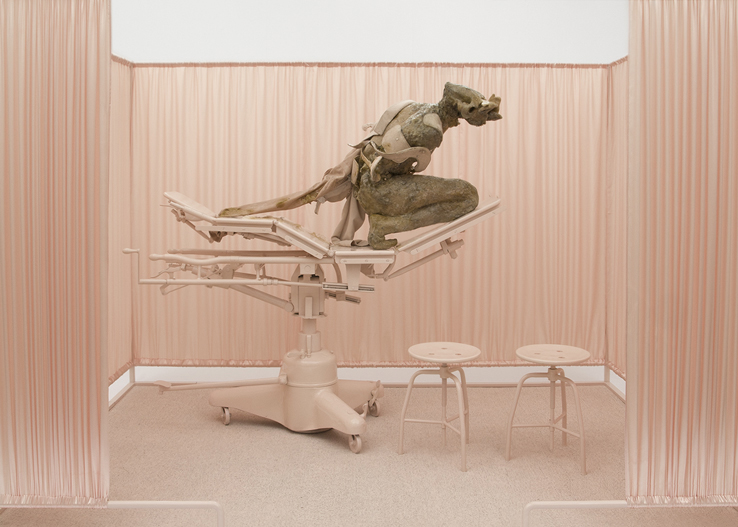
etiology Unknown 02, Jan Manski,
2012 / 200 x 300 x 190 cm (78 3/4 x 118 1/8 x 74 7/8 in)
fat, leather, fur, cosmetics, fabric, polyvinyl acetate, enamel,
steel, surgical table and accessories
photo janmanski.com
Tell us a little about the artist’s book.
I’m working intensively to achieve the perfect light and composition of each piece as I’m against retouching photos. Only natural shots can bring the image closest to the original work. Haselbladt cameras and good light help. It’s not easy for perfectionists like I me to achieve the best possible documentation. I’m particularly proud of the catalogue in the collector’s edition version, its premium print quality and detailed finish makes it a separate piece of art. We’ve put a lot of effort to achieve the best effect we can. Our printers have said that during these projects they felt like they were reaching a new level of artistic prints. There are Onania and Possesia premium catalogues available for view at my representative gallery BREESE LITTLE London.
You work in different mediums: photography, sculpture, video. Is there one that you feel closer to?
My energy feeds off diversity, also in terms of medium. It depends on time really, there is no routine in my schedule. I’m working on many works simultaneously. I switch from medium to medium following my intuition. There is a certain amount of time that one can spend working on a particular piece and medium, keeping the process flowing and being productive. After this time judgement loses its freshness and creativity. When I feel that it’s coming, I switch to a different work and medium. It keeps me going and pushes projects forward day by day.
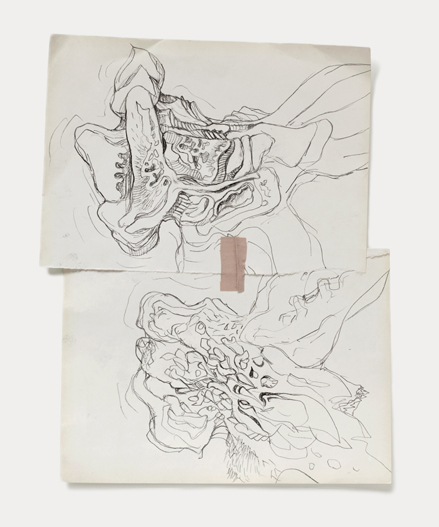
Mutation Study 53, Jan Manski,
2010 / 26 x 32 cm (10 1/16 x 12 9/16 in)
fat, plaster, pencil on paper
photo janmanski.com
Tell us what to expect from Eugenica. When and where will the exhibition take place?
I’m fascinated with bio-engineering and the transformation of Eugenica in relation to modern genetics. The Eugenica series is currently in progress. I’m gathering materials and working on the first definitive pieces. As Eugenica is a futuristic project there will be some digital equipment involved that is new to me. It seems like an exciting trip. I can’t wait to work on it seriously, but to do that I have to gather many, many objects and it takes time. Showing a piece from all three series is an exciting possibility which hopefully may happen in 2015 at BREESE LITTLE. The focus would be to contextualise the three parts and the relationships between them.
Will there be an album with the entire trilogy?
The Onania and Possesia chapters are already printed and waiting for the Eugenica section. There will be also a vast ‘making of’ part. The book will be approximately 150 pages. At 33 x 47 cm it will make a huge catalogue.
What is next for you?
At the moment I’m working on paintings unrelated to the trilogy, something totally different. I think the most fruitful results come when you learn not to fall in love with your work, leave it behind and go further. At the same time I feel content with what I have done so far but I feel like I’m just approaching an end of the beginning.
Jan Manski, February 2014
Jan Manski: POSSESIA at Breese Little, London
27 February – 12 April


























































